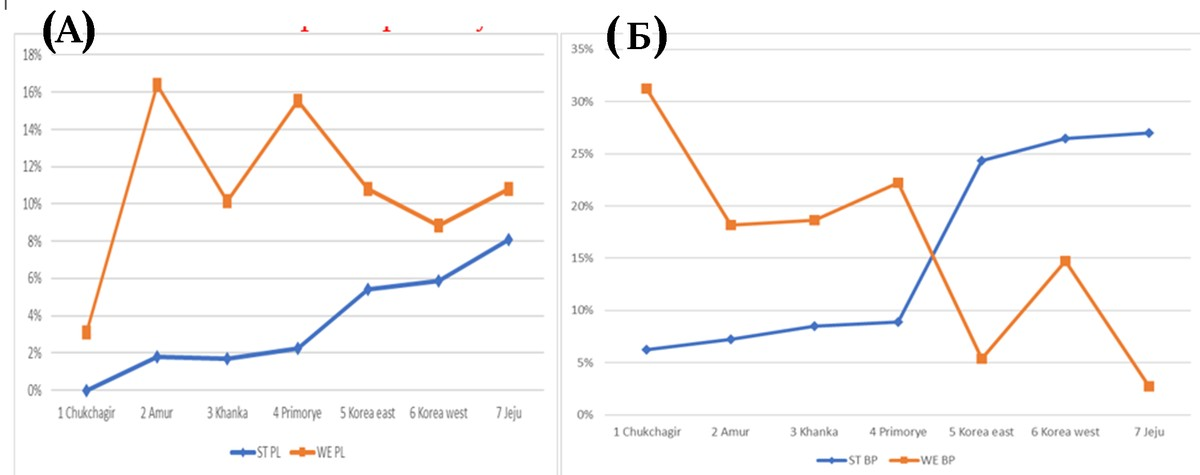
If the biogeography of terrestrial and marine animals is a well-developed branch of biological sciences, then researchers of continental bodies of water still have much to do to adequately understand the modern distribution of organisms and the history of their settlement on the planet. Recently, significant progress has been made in understanding these processes using the example of microscopic crustaceans - water fleas (= Cladocera), which have become a model group of freshwater biogeography. A study of a large array of samples collected in different years in the Russian Far East and on the Korean Peninsula shows a different picture. The Far Eastern region is known as a zone of endemism for cladoceran crustaceans, and is of great interest from the point of view of studying the mechanisms of formation of local faunas as a result of the invasion of “southern” and “northern” species during climatic changes, primarily in the Pleistocene.
Scientists from the Institute of Ecology and Ecology and Evolution of the Russian Academy of Sciences studied the distribution of finds of cladoceran crustaceans, differing in their place of origin, in freshwater reservoirs with different seasonal regimes (permanent and temporary) and belonging to planktonic (that is, living in the water column) or benthic-phytophilic (that is, living in bottom and in coastal thickets) faunas. In addition to the previously demonstrated latitudinal gradient in the proportion of “northern” (northern origin) and “southern” (southern, possibly tropical, origin) species in Cladocera faunas, it was found that in the region it is the planktonic community that includes the largest proportion of endemic species, which are relic from before Pleistocene times.
The scientists have found that the proportion of representatives of the “southern” (tropical) fauna among benthic-phytophilic species drops sharply when moving from south to north, and approximately in the area of North Korea it is replaced by the “northern” (boreal) fauna.
On the contrary, the proportion of representatives of the “southern” fauna in plankton is relatively small (maximum – 16% of the number of finds in each region) even in the extreme south of the studied zone and falls very smoothly when moving north; its complete replacement with the “northern” fauna does not occur. At the same time, many endemics of this region were noted in the plankton.
It is known that these endemics are the remains of ancient, pre-Pleistocene fauna, while the spread of other cladoceran crustaceans to the south and north occurred in the late Pleistocene, and possibly in the Holocene. These results support the previously stated hypothesis that ancient endemics, having a serious “head start” in comparison with “southern” and “northern” species in time, quickly monopolized the water bodies of the Far East in the late Pleistocene and prevented the spread of “southern” species to the north, and “northern” species – to the south. Among representatives of the benthic-phytophilic fauna, their number is significantly lower than in plankton, and it is among their representatives that we can observe a mixture of “southern” and “northern” faunas, which resulted from settlement in the late Pleistocene to the north and south. In this case, the “southern” species prevented the “northern” ones from spreading to the south, and vice versa. On the contrary, relatively few representatives from the north and south were able to penetrate the plankton of this region, since it was already occupied by more successful competitors and more adapted to the conditions of the region - endemics of the Far East.
At present, it is not entirely clear why the proportion of endemics in the Far East is so high in plankton and low in the coastal zone. Directly opposite situations are known, when, for example, in Lake Baikal, the plankton is represented by widespread species, while the benthos contains many endemic species.
“However, in any case, we emphasize the importance of the role of biotic interactions and historical processes in determining modern biogeographic boundaries. If the ecological preferences of a species allow it to spread, for example, to the south during a period of climate warming, this does not mean at all that it will be allowed to do so. " – says Doctor of Biological Sciences, corresponding member of RAS A.A. Kotov, who is in charge of this research. Undoubtedly, such studies will be continued by the staff of the Institute of Ecology and Evolution of the Russian Academy of Sciences.
The research was carried out within the framework of the State assignment AAAA-A18-118042490059-5. The article was published in the magazine "Water".
Ivan I. Krolenko, Petr G. Garibian and Alexey A. Kotov The Role of Old Relicts in Structuring the Boreal/Tropical Transitional Zone: The Case of East Asian Planktonic Cladocera (Crustacea) Diversity 2023, 15, 713. https://doi.org/10.3390/d15060713
Related materials:
RAS: "The influence of relict planktonic crustaceans on the settlement of the Far East in the
Pleistocene"
